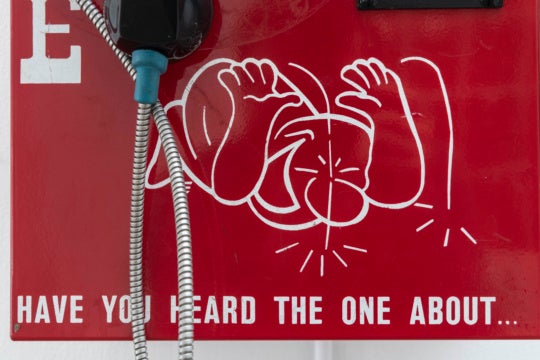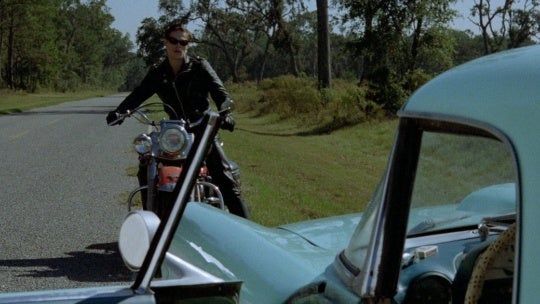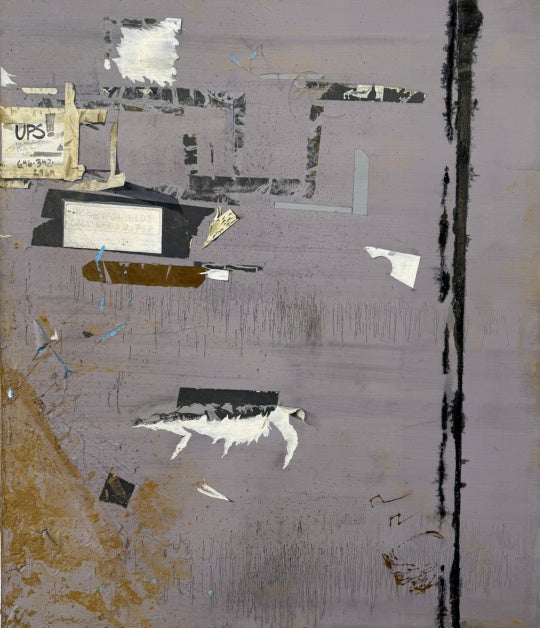
Beth Foley’s recent exhibition of paintings at David Lusk Gallery in Nashville included fewer than 10 works, but the dense detailing of the referential, symbolic, and historical content displayed left plenty to perceive. In “Murders, Misfits and Other Unpleasantries,” the artist brought her keen insights and dexterity to explorations both personal and criminological, featuring imagery pulled from her own family history and the lore of actual – and fantastical – killers.
Foley’s paintings comprise equal parts of detailed realism and cartoonish stylization; the finished product presents such a flat, uniform surface that, at first glance, it’s unclear whether you’re actually looking at a painting. All the works that were in the exhibition are figurative and narrative, yet even when the story isn’t that apparent, the gestures, expressions, and overall composition of her works fill their frames with drama, humor, and mystery.

Foley’s work simultaneously reminds me of looking at Indian miniature paintings and examining meticulously devised cels from an animated film. And like both mythic illustrations and cartoons, Foley’s frames are filled with bizarre and magical happenings. In Hansel, Gretel and the Ghost Children, Hansel and Gretel are standing in a house’s front yard, trying to decide whether or not to trust the old lady who’s offering them gingerbread cookies. The yard is full of other children, all surrounded by glowing halos of white light, while each of their shirts or jackets are adorned with a yellow star. The chimney of the house erupts in an ominous plume of ash gray smoke. Here, Foley is comparing the cooking of children in the fairy tale to the infamous ovens of Dachau and Auschwitz. Though on a deeper level, she’s also pointing at that place in the German psyche that might of conceived such a diabolical story as well as the “Final Solution.”
In ‘To Be Born Again,’ Sang Gibreel Frarishta Rumbling From The Heavens, ‘First You Have To Die,’ the artist pictures her grandfather and father, both deceased, embracing in the night sky above Philadelphia. The painting recalls the constellation of Gemini, yet Foley transforms the symbol of twins into father and son, both dressed in dapper jackets and ties, and topped with caps of silver hair.

In addition to fairy tale baddies and the artist’s real-life family, “Murders, Misfits and Other Unpleasantries” also featured cameos by two pairs of infamous killers. Criminals in Cars: Leopold and Loeb pictures two young men, Nathan Leopold and Richard Loeb, cruising in a Willys-Knight, having just spotted 14-year-old Robert Franks on a quiet street in suburban Chicago in May of 1924. The alliterative pair, who were wealthy students at the University of Chicago, kidnapped and killed Franks, stabbing him in the head with a chisel, then suffocating the boy with a rag in the back seat of a rented car. In the painting, Foley’s flattened imagery and the indifferent facial expressions hint at the coldblooded chaos to come.
Criminals in Cars: Dick and Perry points to comedian Jerry Seinfeld’s Comedians in Cars Getting Coffee web series, but the names “Dick” and “Perry” are immediately recognizable to any reader of Truman Capote’s In Cold Blood. Another pair of bad eggs, in 1959, Dick and Perry invaded a farmhouse in Holcomb, Kansas, killing four members of the Clutter family. The painting pictures the two men driving past a “H. Clutter River Valley Farm” sign on a dirt road beneath a full moon. From the position of the sign and the house in the background, the two appear to be leaving the Clutter farm, having made sure to leave no witnesses to their botched robbery of a non-existent safe.
Joe Nolan is a critic, columnist, and intermedia artist in Nashville. Find out more about his projects at www.joenolan.com.




